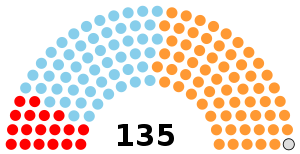1924 South African general election
The 1924 South African general election was a realigning election in the Union of South Africa's House of Assembly held on 19 June 1924 to elect 135 members. Rising discontent with the government of Jan Smuts led to the defeat of his government by a coalition of the pro-Afrikaner National Party and the South African Labour Party, a socialist party representing the interests of the white proletariat.
| |||||||||||||||||||||||||||||||||||||||||
All 135 seats in the House of Assembly 68 seats needed for a majority | |||||||||||||||||||||||||||||||||||||||||
|---|---|---|---|---|---|---|---|---|---|---|---|---|---|---|---|---|---|---|---|---|---|---|---|---|---|---|---|---|---|---|---|---|---|---|---|---|---|---|---|---|---|
| Turnout | 77.22% ( | ||||||||||||||||||||||||||||||||||||||||
| |||||||||||||||||||||||||||||||||||||||||
 House of Assembly after the election | |||||||||||||||||||||||||||||||||||||||||
| |||||||||||||||||||||||||||||||||||||||||
 |
|---|
| This article is part of a series on the politics and government of South Africa |
|
|
|
Related topics |
|
|
Smuts had angered South African nationalists by his moderate stance on South African independence from the British Empire. The worldwide depression after the end of the First World War had led to a strike in South Africa, known as the Rand Rebellion, which had been defused through a combination of military force and negotiation with the outgunned unions, earning Smuts the enmity of the labour vote. As a consequence Smuts's SAP was defeated by a Nationalist–Labour Pact, James Hertzog formed the government and became prime minister – a position he was to hold until 1939.
Delimitation of electoral divisions
The South Africa Act 1909 had provided for a delimitation commission to define the boundaries for each electoral division. The representation by province, under the fourth delimitation report of 1923, is set out in the table below. The figures in brackets are the number of electoral divisions in the previous (1919) delimitation. If there is no figure in brackets then the number was unchanged.[1]
| Provinces | Cape | Natal | Orange Free State | Transvaal | Total |
|---|---|---|---|---|---|
| Divisions | 51 | 17 | 17 | 50 (49) | 135 (134) |
Results
The vote totals in the table below may not give a complete picture of the balance of political opinion, because of unopposed elections (where no votes were cast) and because contested seats may not have been fought by a candidate from all major parties.
The total registered electorate was 413,136. The votes cast were 319,047 (including 2,805 spoilt votes).[2]
| Party | Seats[3] | Seats % | Votes[4] | Votes % | Leader | |
| National Party | 63 | 46.67 | 111,483 | 35.25 | General J. B. M. Hertzog | |
| South African | 53 | 39.26 | 148,769 | 47.04 | General Jan Smuts | |
| Labour | 18 | 13.33 | 45,380 | 14.35 | Colonel F. H. P. Creswell | |
| Independent | 1 | 0.74 | 10,610 | 3.36 | - | |
| Total | 135 | |||||
References
- South Africa 1982: Official Yearbook of the Republic of South Africa, published by Chris van Rensburg Publications
- South Africa 1982, page 129
- South Africa 1982, page 176
- South Africa 1982, page 174 (seats by party)
- South Africa 1982, page 176 (votes by party)
.jpg)
.jpg)
.jpg)